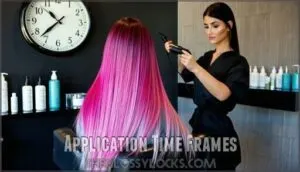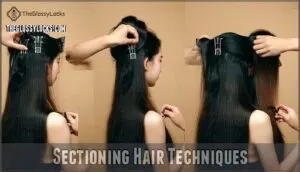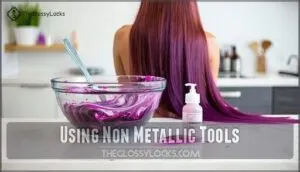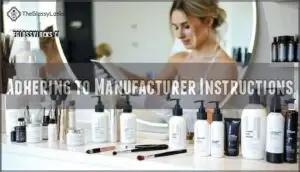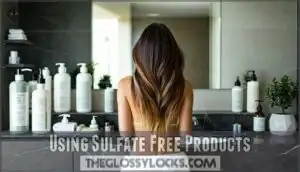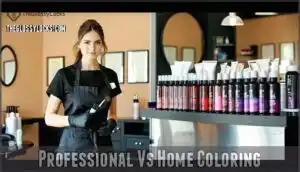This site is supported by our readers. We may earn a commission, at no cost to you, if you purchase through links.

You’ll need to do patch tests 48 hours before application and choose the right developer strength for your hair type.
Never rush the process; follow timing instructions exactly since over-processing causes breakage while under-processing leaves patchy results.
Prep your hair properly by sectioning it into quarters and using non-metallic tools only.
After coloring, wait 72 hours before shampooing and switch to sulfate-free products to protect your investment.
The difference between salon-worthy results and a color catastrophe often comes down to mastering these fundamental techniques.
Table Of Contents
- Key Takeaways
- Pre Application Tips
- Application Time Frames
- Hair Preparation Methods
- Post Application Care
- Professional Vs Home Coloring
- Frequently Asked Questions (FAQs)
- What should be avoided before applying permanent hair color?
- How long should you leave permanent hair color on?
- How often should you recolor permanent hair dye?
- Will permanent color work on previously bleached hair?
- Does permanent dye cover all gray hair types?
- Can you swim immediately after permanent hair coloring?
- Conclusion
Key Takeaways
- Always do patch and strand tests 48 hours before application – you’ll avoid allergic reactions and preview your color results on hidden hair sections before committing to the full process.
- Choose the right developer strength for your hair type and desired results – you’ll prevent damage by matching 10-40 volume developers to your hair’s porosity and the amount of lift you need.
- Follow timing instructions exactly and never rush the process – you’ll get even coverage by processing for the recommended 35-40 minutes, as over-processing causes breakage while under-processing leaves patchy results.
- Wait 72 hours before shampooing and switch to sulfate-free products – you’ll lock in your color investment by allowing cuticles to seal completely and using gentle formulas that won’t strip your fresh dye.
Pre Application Tips
Proper preparation prevents permanent hair color disasters and protects your hair’s health.
You’ll need to complete patch tests, choose the right developer strength, and avoid harsh chemicals that can damage your strands.
Avoiding Harsh Chemicals
Most permanent hair dyes contain ammonia and peroxide that strip your hair’s natural moisture.
Ammonia and peroxide work like chemical bulldozers, demolishing your hair’s protective moisture barrier with every application.
You’ll break free from damage by choosing chemical-free alternatives like henna or plant-based formulas.
These gentle ingredients protect your strands while delivering vibrant color.
Safe ingredients mean healthier hair—your locks deserve natural dyes that nourish instead of harsh chemicals that destroy.
Choosing Right Developer
Developer types dictate how permanent hair color processes.
You’ll choose between 10, 20, 30, or 40 volume based on your hair porosity and desired lift.
Lower volumes deposit color without significant lifting, while higher volumes contain stronger lifting agents for dramatic changes.
Match developer strength to your color formulas and hair condition.
Remember, toner selection requires precise developer pairing for effective color deposit results.
Understanding hair porosity levels is essential for achieving the desired hair lightening effect, and it’s crucial to consider desired lift when making your selection.
Patch and Strand Tests
Testing prevents disasters.
Always conduct patch tests 48 hours before applying permanent hair color to check for dye sensitivity and potential color reactions.
Apply a small amount behind your ear for allergy checks.
Perform strand tests on hidden hair sections to preview results.
This hair sampling reveals how your color treated hair will respond.
These test timing protocols are essential hair dye advice that professional colorists swear by for safe hair color care.
Application Time Frames
Getting the timing right for permanent hair color makes the difference between vibrant, long-lasting results and damaged, disappointing hair.
You’ll need to follow strict processing times—typically 35-40 minutes—to achieve proper color development without compromising your hair’s health.
Processing Time Guidelines
When timing your permanent dye application, you’ll achieve salon-quality results by following manufacturer guidelines precisely.
Set a timer for 35-45 minutes after completing application—this window allows complete color development without hair damage.
Developer ratios and color timing work together, so resist checking too early, as processing errors happen when you rush or extend beyond recommended timing guidelines, compromising your hair color products’ effectiveness and requiring costly color correction later.
To achieve superior results, consider the importance of proper hair dye application techniques, which is crucial for the overall quality of the dye job and to prevent the need for costly color correction.
Over Processing Risks
Leaving color on too long wreaks havoc on your hair’s internal structure, causing severe hair damage and breakage that can take months to repair.
Over-processing leads to chemical burns, scalp irritation, and color fade as your hair becomes too porous to hold pigment properly, requiring costly color correction treatments.
Understanding the effects of hair color damage is essential to maintaining healthy hair and avoiding unnecessary repairs.
Under Processing Consequences
Processing errors plague rushed color applications.
You can’t rush permanent hair color without consequences.
Under processing creates patchy coverage, color fade happens faster, and hair dye removal becomes necessary.
Your hair color maintenance suffers when processing errors occur.
Incomplete color penetration means uneven results across color treated hair.
Following hair color tips prevents hair damage and fading risks from inadequate processing time, which can lead to the need for hair dye removal.
Hair Preparation Methods
Proper hair preparation makes the difference between salon-quality color and a DIY disaster.
You’ll need to section your hair systematically, use non-metallic tools, and follow timing instructions precisely to achieve even coverage without damage.
Sectioning Hair Techniques
Divide your hair into four quadrants using horizontal and vertical Hair Parting lines from ear to ear and forehead to nape.
This Hair Sectioning method guarantees even Root Application and prevents missed spots.
Secure each section with clips, creating manageable Strand Division for systematic permanent hair color coverage.
Professional Clip Techniques involve twisting sections away from your working area, maintaining organization throughout the hair coloring process, which ensures complete concepts are applied for best results.
Using Non Metallic Tools
Always choose metal alternatives for hair coloring to prevent adverse chemical reactions that can compromise color accuracy and hair protection.
Tool safety demands using plastic, glass, or porcelain mixing bowls and applicator brushes when working with permanent hair color formulations.
When preparing for hair coloring, you must have the right equipment, including high-quality glass mixing tools.
- Stainless steel bowls can turn your dream blonde into a muddy mess
- Metal brushes create hot spots that literally fry your hair strands
- Aluminum foil alternatives protect your scalp from chemical burns
- Glass mixing containers let you see true color development
- Plastic applicator bottles give you complete control over placement
Adhering to Manufacturer Instructions
Following manufacturer instructions isn’t just about user compliance—it’s your roadmap to chemical safety and professional results.
Each hair color guide provides specific product guidelines for developer ratios, processing times, and application techniques.
Reading label directions thoroughly prevents costly mistakes and protects your hair’s integrity.
Your permanent hair color chart indicates precise formulations, while proper instruction adherence guarantees minimal damage risks and minimizes damage risks.
Understanding hair color products is vital for achieving the desired results and maintaining healthy hair.
Post Application Care
Once you apply permanent hair color, the next 72 hours are vital for locking in your results.
You’ll need to skip shampooing and switch to sulfate-free products to protect your investment and keep that fresh color vibrant longer.
This will help to ensure the color remains vibrant and lasts as expected.
Waiting Period Before Shampoo
Most permanent hair color needs three full days to lock in properly. This shampoo delay allows cuticles to seal completely, preventing color molecules from washing out prematurely.
Here’s your color protection timeline:
- Day 1-3: Skip all water contact on hair to maximize color lock and moisture retention
- Monitor scalp sensitivity: Watch for irritation during the waiting period before first wash
- Assess hair porosity: Highly porous hair may need extended delay for ideal color absorption
- Use dry shampoo sparingly: Only if absolutely necessary for oil control during wait period
- Plan ahead: Schedule permanent hair color application when you can avoid washing for 72 hours
Using Sulfate Free Products
Sulfate alternatives reveal better color preservation for your permanent color investment.
Gentle shampoos with mild surfactants protect hair moisture while traditional sulfates strip dye molecules within days.
Color safe shampoo formulas maintain vibrant results longer.
Check product ingredients carefully—sulfate free products extend your color’s lifespan substantially.
This simple swap delivers professional-level hair color help at home.
Using a sulfate free shampoo is essential for preserving keratin treated hair and maintaining its health and color.
Minimizing Color Fading
Preservation becomes your color’s best friend when you’re armed with the right strategies. Your permanent color deserves protection from environmental aggressors that cause premature fading.
- Wash with color safe shampoo – Choose sulfate-free formulas that won’t strip your hair color while maintaining hair moisture
- Limit heat styling – High temperatures break down color molecules, reducing vibrancy maintenance and longlasting results
- Use UV protection – Sun exposure fades permanent color faster than washing, so apply leave-in treatments with SPF
- Cold water rinses – Hot water opens cuticles and releases pigment, while cool water promotes color locking
- Deep condition weekly – Healthy hair holds color better than damaged strands, preventing your investment from washing down the drain
Using a color safe product is essential for maintaining color-treated hair.
Professional Vs Home Coloring
You’ll find significant differences between professional salon coloring and home box dyes that affect both your hair’s health and color results.
Professional colorists use higher-quality formulas and customize treatments for your specific hair type, while box dyes contain harsher chemicals and offer limited shade options.
Benefits of Salon Services
Professional salon services deliver custom color suited to your skin tone and hair type.
You’ll receive personalized service with expert guidance throughout the process.
The salon experience includes superior hair health protection and professional advice for maintenance.
| Benefit | Salon Service | Home Kit |
|---|---|---|
| Color Match | Customized to you | One-size-fits-all |
| Hair Health | Protected formula | Harsh chemicals |
| Results | Even, lasting color | Patchy coverage |
Risks of Box Dyes
Box dyes contain pre-mixed formulas with harsher toxic chemicals like ammonia that can cause chemical burns, scalp irritation, and allergic reactions.
Box dyes pack harsh ammonia that burns your scalp and damages your hair beyond repair.
These hair color brands aren’t customized for your specific hair type, increasing risks of color damage and hair loss compared to semipermanent hair dye options.
Understanding the hair dye risks is essential for making informed decisions about hair coloring.
| Risk Factor | Box Dye Impact | Professional Alternative |
|---|---|---|
| Chemical Concentration | Higher ammonia levels cause burns | Customized developer strength |
| Allergic Reactions | Unknown sensitivity to harsh ingredients | Patch testing with gentler formulas |
| Color Damage | Unpredictable results, permanent mistakes | Color-matched application techniques |
| Scalp Irritation | One-size-fits-all approach ignores sensitivity | Scalp analysis before treatment |
| Hair Loss | Over-processing from incorrect timing | Professional monitoring during process |
Corrective Treatment Options
When box dyes fail, color correction becomes your lifeline.
Professional stylists use pigment removal, bleach application, and toner applications to fix brassy tones and uneven results. Hair restoration requires multiple sessions for significant damage repair.
| Treatment Type | Best For |
|---|---|
| Color Stripping | Removing artificial pigment buildup |
| Bleach Correction | Lightening for dramatic color changes |
| Toning | Eliminating brassy, unwanted hues |
| Bond Repair | Restoring hair strength post-treatment |
Long Term Color Maintenance
While corrective treatments can rescue damaged hair, smart color longevity planning saves money long-term.
You’ll need regular touch-ups as hair regrowth reveals natural roots.
Professional color preservation methods outperform DIY approaches for vibrancy maintenance and shade matching consistency.
| Maintenance Aspect | Professional Service | At-Home Care |
|---|---|---|
| Touch-up Frequency | Every 6-8 weeks with precise shade matching | Every 4-6 weeks, potential color drift |
| Fading Prevention | Custom toners and color-safe treatments | Basic sulfate-free shampoos only |
| Hair Health | Conditioning treatments prevent damage buildup | Limited repair options between applications |
| Cost Over Time | Higher upfront, fewer corrections needed | Lower initial cost, frequent product purchases |
Frequently Asked Questions (FAQs)
What should be avoided before applying permanent hair color?
You’ll want to avoid washing your hair 24-48 hours beforehand, skipping the patch test, using metallic hair tools, and applying color to damaged or chemically-treated hair without proper timing.
How long should you leave permanent hair color on?
Picture vibrant color molecules penetrating each hair strand, transforming your look with chemical precision.
You’ll typically leave permanent hair color on for 35-40 minutes, following manufacturer instructions exactly to avoid damage or incomplete coverage, using precision to ensure the best results.
How often should you recolor permanent hair dye?
You’ll typically need to recolor permanent hair dye every 4-6 weeks when root regrowth becomes noticeable. Your hair’s growth rate and desired look determine the exact timing for touch-ups.
Will permanent color work on previously bleached hair?
Yes, permanent color works on bleached hair, but it’ll grab differently than virgin strands.
You’ll get more vibrant results since bleach opened your hair cuticles, making them super receptive to new pigment deposits, with more vibrant results being the key outcome.
Does permanent dye cover all gray hair types?
Permanent dye provides excellent gray coverage for most hair types, though coarse or resistant grays may need longer processing time or a stronger developer for complete results.
Can you swim immediately after permanent hair coloring?
Sarah’s stylist warned her against swimming for 72 hours after her color treatment, but she jumped in anyway and watched her new auburn shade wash down the pool drain.
Wait 72 hours before swimming after permanent hair coloring. Chlorine and saltwater strip fresh color, causing fading and uneven patches that’ll ruin your investment.
Conclusion
Mastering permanent hair color advice requires patience and precision, much like developing a daguerreotype in photography’s early days.
You’ve learned the essential techniques that separate professional results from amateur disasters.
Remember to always perform patch tests, choose appropriate developer strength, and follow timing guidelines exactly.
Proper sectioning and non-metallic tools guarantee even application, while sulfate-free aftercare protects your investment.
These fundamentals will give you salon-quality results at home when executed correctly.
- https://www.clairol.com/en-US/blog/hair-coloring/coloring-hair-at-home
- https://www.redken.com/blog/is-permanent-haircolor-right-for-you.html
- https://www.sallybeauty.com/just-ask-sally/articles/pro-talk-hair-color-tips/
- https://www.wella.com/international/wella-magazine/top-10-coloring-tips-your-best-hair-color-results
- https://www.glamot.com/blog/32678/10-common-mistakes-you-re-making-when-dyeing-hair

